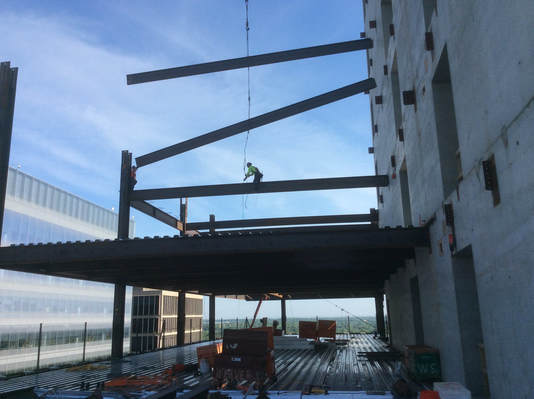|
SUMMARY Multiple lift rigging, or “christmas treeing,” is prohibited for construction activities other than steel erection because of the hazards involved, including beams hitting other objects or people. OSHA’s Sub Part R 1926.753 addresses the use multiple lift rigging assemblies, and a 2005 OSHA letter of interpretation provides additional explanation. Because of the necessity for this work practice in steel erection, crew members should understand the dangers and follow best practices. According to the 2005 letter from OSHA, during the multiple lift procedure, the hoisted beams need to be attached to the rigging assembly beginning with the topmost attachment. That means that workers have to be under the already-attached members while continuing the attachment process. Also, the hoisted members are detached from the assembly beginning with the bottom member, so employees are under the remaining members during the unhooking phase of the operation, as described in Volume 66 of the Federal Register, January 18, 2001.
OSHA states that the maximum length of a multiple rigging assembly is 35 ft. The minimum vertical spacing between each piece is 7 ft. The maximum number of steel beams allowed to be lifted in a multiple rigging assembly is five. Most steel erectors are familiar with the above rule; however, a general contractor may not allow five pieces to be hoisted at one time. If that’s the case, it’s prudent to increase the vertical spacing between beams, if possible. BEST PRACTICES In-house devices, such as multiple slings bunched together, cannot be used for multiple beam lifting. Not every rigging shop will design and build an assembly for you. OSHA says the rigging assembly must be designed, built, and tested by a qualified rigging shop. If the general contractor won’t allow you to pick a total of five beams, you’ll have to increase the vertical space between beams. If you’re only picking three beams at a time, increase the vertical distance between beams, if possible, within that 35-ft. length to 10 feet or so as an added measure of safety. For example, consider changing the formula from 35-7-5 to 28-8-3. Modifying the process won’t affect the productivity, but it will reduce the chances of a beam coming in contact with a person or object as it is being delivered. The use of positive locking hooks helps to prevent rollout, where either the sling or the load can roll and cause the sling to come out of the bowl of the hook. A hook with a safety latch is designed to keep the rigging from popping out. A positive locking hook will prevent anything from coming out of the hook. OSHA’s rules for multiple lift rigging procedure: 1926.753(e)(1) - A multiple lift shall only be performed if the following criteria are met:
1926.753(e)(2) - Components of the multiple lift rigging assembly shall be specifically designed and assembled with a maximum capacity for total assembly and for each individual attachment point. This capacity, certified by the manufacturer or a qualified rigger, shall be based on the manufacturer's specifications with a 5 to 1 safety factor for all components. 1926.753(e)(3) - The total load shall not exceed:
1926.753(e)(4) - The multiple lift rigging assembly shall be rigged with members:
1926.753(e)(5) - The members on the multiple lift rigging assembly shall be set from the bottom up. 1926.753(e)(6) - Controlled load lowering shall be used whenever the load is over the connectors. Additional Resources: OSHA Steel Erection eTool https://www.osha.gov/SLTC/etools/steelerection/cranes.html OSHA Interpretation Letter, whether multiple lift of pre-cast concrete is permissible https://www.osha.gov/laws-regs/standardinterpretations/2009-04-03 This Safety Flash was contributed by Tom McAleese, Lifting Specialist, Indusco Wire Rope & Supplies, a Mazzella Company, Baltimore, Md., in cooperation with SEAA’s Safety Committee. It is designed to keep members informed about ongoing safety issues and to provide suggestions for reducing risk. Best practices are gathered from a variety of sources. They may be more or less stringent than individual corporate policies, and are not intended to be an official recommendation from SEAA. Always get approval and direction from your company officers on any new practice or procedure as these best practices may not work for all situations. Everyone benefits when a worker avoids injury. Submit your ideas for Safety Flash to [email protected]. Comments are closed.
|



 RSS Feed
RSS Feed
